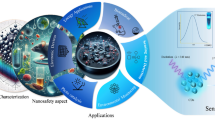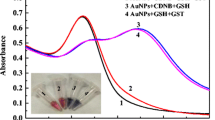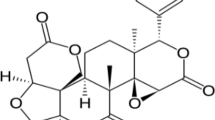Abstract
A kind of single-layer carbon based dots (CDs) with abundant carboxyl functional groups was hybridized with manganese dioxide (MnO2). The resulting nanohybrid is stable and can be well dispersed in water. MnO2 is capable of oxidizing the substrate 3,3′5,5′-tetramethylbenzidine (TMB) to form a blue product whose absorption (peaking at 655 nm) fades in the presence of glutathione (GSH). A sensitive and selective colorimetric GSH assay was worked out that has a linear response in the 10 to 0.1 µM GSH concentration range, with a 0.095 μM detection limit. The method was applied to the determination of GSH in spiked fetal calf serum where it gave excellent recoveries.

Schematic of the preparation of a nanohybrid composed of manganese dioxide and carbon based dots (MnO2/CDs). They can be used for the colorimetric detection of glutathione (GSH) based on the color change of 3,3′5,5′-tetramethylbenzidine (TMB).





Similar content being viewed by others
References
Li M, Wu X, Wang Y, Li Y, Zhu W, James TD (2014) A near-infrared colorimetric fluorescent chemodosimeter for the detection of glutathione in living cells. Chem Commun 50:1751–1753
Shi Y, Pan Y, Zhang H, Zhang Z, Li MJ, Yi C, Yang M (2014) A dual-mode nanosensor based on carbon quantum dots and gold nanoparticles for discriminative detection of glutathione in human plasma. Biosens Bioelectron 56:39–45
Schirmer RH, Müller JG, Krauth-Siegel RL (1995) Disulfide-reductase inhibitors as chemotherapeutic agents: the design of drugs for trypanosomiasis and malaria. Angew Chem Int Ed 34:141–154
Ni P, Sun Y, Dai H, Hu J, Jiang S, Wang Y, Li Z (2015) Highly sensitive and selective colorimetric detection of glutathione based on ag [I] ion-3,3′,5,5′-tetramethylbenzidine (TMB). Biosens Bioelectron 63:47–52
Herzenberg LA, De Rosa SC, Dubs JG, Roederer M, Anderson MT, Ela SW, Deresinski SC, Herzenberg LA (1997) Glutathione deficiency is associated with impaired survival in HIV disease. P Natl Acad Sci 94:1967–1972
Park KS, Kim MI, Woo MA, Park HG (2013) A label-free method for detecting biological thiols based on blocking of Hg2+-quenching of fluorescent gold nanoclusters. Biosens Bioelectron 45:65–69
Christensen CW, Rieder MA, Silverstein EL, Gencheff NE (1995) Magnesium sulfate reduces myocardial infarct size when administered before but not after coronary reperfusion in a canine model. Circulation 92:2617–2621
Wang C, Liu L, Cao H, Zhang W (2017) Intracellular GSH-activated galactoside photosensitizers for targeted photodynamic therapy and chemotherapy. Biomater Sci 5:274–284
Feng J, Huang P, Shi S, Deng KY, Wu FY (2017) Colorimetric detection of glutathione in cells based on peroxidase-like activity of gold nanoclusters: a promising powerful tool for identifying cancer cells. Anal Chim Acta 967:64–69
Dong ZZ, Lu L, Ko CN, Yang C, Li S, Lee MY, Leung CH, Ma DL (2017) A MnO 2 nanosheet-assisted GSH detection platform using an iridium (iii) complex as a switch-on luminescent probe. Nano 9:4677–4682
Li H, Peng W, Feng W, Wang Y, Chen G, Wang S, Li S, Wang K, Zhang J (2016) A novel dual-emission fluorescent probe for the simultaneous detection of H2S and GSH. Chem Commun 52:4628–4631
Wang P, Wang Y, Li N, Huang J, Wang Q, Gu Y (2017) A novel DCM-NBD conjugate fluorescent probe for discrimination of Cys/Hcy from GSH and its bioimaging applications in living cells and animals. Sens Actuat B: Chem 245:297–304
Sezgintürk MK, Dinçkaya E (2011) Glutathione (GSH) determination by a very simple electrochemical method. Int J Pept Res Ther 17:87–92
Fracassetti D, Tirelli A (2015) Monitoring of glutathione concentration during winemaking by a reliable high-performance liquid chromatography analytical method. Aust J Grape Wine R 21:389–395
Huang ZM, Cai QY, Ding DC, Ge J, Hu YL, Yang J, Zhang L, Li ZH (2017) A facile label-free colorimetric method for highly sensitive glutathione detection by using manganese dioxide nanosheets. Sensor Actuat B: Chem 242:355–361
Zhang T, Lu Y, Luo G (2014) Synthesis of hierarchical iron hydrogen phosphate crystal as a robust peroxidase mimic for stable H2O2 detection. ACS Appl Mater Inter 6:14433–14438
Jiang Z, Liu Y, Hu X, Li Y (2014) Colorimetric determination of thiol compounds in serum based on Fe-MIL-88NH2 metal-organic framework as peroxidase mimetics. Anal Methods 6:5647–5651
Xu HH, Deng HH, Lin XQ, Wu YY, Lin XL, Peng HP, Liu AL, Xia XH, Chen W (2017) Colorimetric glutathione assay based on the peroxidase-like activity of a nanocomposite consisting of platinum nanoparticles and graphene oxide. Microchim Acta 184:3945–3951
Dong Y, Pang H, Yang HB, Guo C, Shao J, Chi Y, Li CM, Yu T (2013) Carbon-based dots co-doped with nitrogen and sulfur for high quantum yield and excitation-independent emission. Angew Chem Int Ed 52:7800–7804
Cao L, Wang X, Meziani MJ, Lu F, Wang H, Luo PG, Lin Y, Harruff BA, Veca LM, Murray D (2007) Carbon dots for multiphoton bioimaging. J Am Chem Soc 129:11318–11319
Cai W, Chen X (2008) Preparation of peptide-conjugated quantum dots for tumor vasculature-targeted imaging. Nat Protoc 3:89–96
Sun H, Gao N, Wu L, Ren J, Wei W, Qu X (2013) Highly photoluminescent amino-functionalized graphene quantum dots used for sensing copper ions. Chem Eur J 19:13362–13368
Sun X, Lei Y (2017) Fluorescent carbon dots and their sensing applications. TrAC Trend Anal Chem 89:163–180
Lin L, Rong M, Luo F, Chen D, Wang Y, Chen X (2014) Luminescent graphene quantum dots as new fluorescent materials for environmental and biological applications. TrAC Trend Anal Chem 54:83–102
Jin JC, Xu ZQ, Dong P, Lai L, Lan JY, Jiang FL, Liu Y (2015) One-step synthesis of silver nanoparticles using carbon dots as reducing and stabilizing agents and their antibacterial mechanisms. Carbon 94:129–141
Jiang X, Geng F, Wang Y, Liu J, Qu P, Xu M (2016) Fluorescence turn-on and colorimetric dual readout assay of glutathione over cysteine based on the fluorescence inner-filter effect of oxidized TMB on TMPyP. Biosens Bioelectron 81:268–273
Liu J, Meng L, Fei Z, Dyson PJ, Jing X, Liu X (2017) MnO2 nanosheets as an artificial enzyme to mimic oxidase for rapid and sensitive detection of glutathione. Biosens Bioelectron 90:69–74
He D, Yang X, He X, Wang K, Yang X, He X, Zou Z (2015) A sensitive turn-on fluorescent probe for intracellular imaging of glutathione using single-layer MnO2 nanosheet-quenched fluorescent carbon quantum dots. Chem Commun 51:14764–14767
Gao T, Glerup M, Krumeich F, Nesper R, Fjellvåg H, Norby P (2008) Microstructures and spectroscopic properties of cryptomelane-type manganese dioxide nanofibers. J Phys Chem C 112:13134–13140
Li B, Rong G, Xie Y, Huang L, Feng C (2006) Low-temperature synthesis of α-MnO2 hollow urchins and their application in rechargeable li+ batteries. Inorg Chem 45:6404–6410
Qu Q, Zhang P, Wang B, Chen Y, Tian S, Wu Y, Holze R (2009) Electrochemical performance of MnO2 nanorods in neutral aqueous electrolytes as a cathode for asymmetric supercapacitors. J Phys Chem C 113:14020–14027
Liu X, Wang Q, Zhang Y, Zhang L, Su Y, Lv Y (2013) Colorimetric detection of glutathione in human blood serum based on the reduction of oxidized TMB. New J Chem 37:2174–2178
Yan X, Song Y, Wu X, Zhu C, Su X, Du D, Lin Y (2017) Oxidase-mimicking activity of ultrathin MnO2nanosheets in colorimetric assay of acetylcholinesterase activity. Nano 9:2317–2323
Ju J, Zhang R, Chen W (2016) Photochemical deposition of surface-clean silver nanoparticles on nitrogen-doped graphene quantum dots for sensitive colorimetric detection of glutathione. Sensors Actuat B: Chem 228:66–73
Wu D, Li G, Chen X, Qiu N, Shi X, Chen G, Sun Z, You J, Wu Y (2017) Fluorometric determination and imaging of glutathione based on a thiol-triggered inner filter effect on the fluorescence of carbon dots. Microchim Acta 184:1923–1931
Ji D, Meng H, Ge J, Zhang L, Wang H, Bai D, Li J, Qu L, Li Z (2017) Ultrasensitive fluorometric glutathione assay based on a conformational switch of a G-quadruplex mediated by silver(I). Microchim Acta 184:3325–3332
Guo Y, Yang L, Li W, Wang X, Shang Y, Li B (2016) Carbon dots doped with nitrogen and sulfur and loaded with copper(II) as a “turn-on” fluorescent probe for cystein, glutathione and homocysteine. Microchim Acta 183:1409–1416
Yang R, Guo X, Jia L, Zhang Y (2017) A fluorescent “on-off-on” assay for selective recognition of cu(II) and glutathione based on modified carbon nanodots, and its application to cellular imaging. Microchim Acta 184:1143–1150
Shamsipur M, Safavi A, Mohammadpour Z (2014) Indirect colorimetric detection of glutathione based on its radical restoration ability using carbon nanodots as nanozymes. Sensors Actuat B: Chem 199:463–469
Zou H, Yang T, Lan J, Huang C (2017) Use of the peroxidase mimetic activity of erythrocyte-like Cu1.8S nanoparticles in the colorimetric determination of glutathione. Anal Methods 9:841–846
Acknowledgements
This study was financially supported by National Key Research and Development Program of China (2017YFC1600500), National Natural Science Foundation of China (21675026, 21675027, 21506029), Natural Science Foundation of Fujian Province (2017Y01010023).
Author information
Authors and Affiliations
Corresponding authors
Ethics declarations
The author(s) declare that they have no competing interests.
Electronic supplementary material
ESM 1
(DOCX 47 kb)
Rights and permissions
About this article
Cite this article
Wang, Q., Pang, H., Dong, Y. et al. Colorimetric determination of glutathione by using a nanohybrid composed of manganese dioxide and carbon dots. Microchim Acta 185, 291 (2018). https://doi.org/10.1007/s00604-018-2830-6
Received:
Accepted:
Published:
DOI: https://doi.org/10.1007/s00604-018-2830-6




